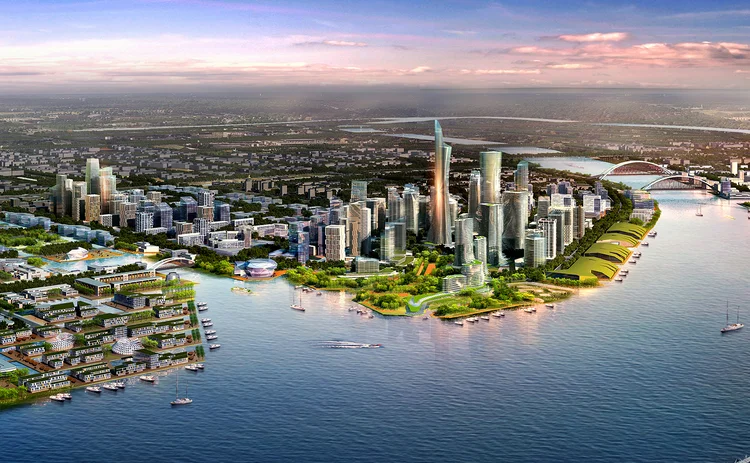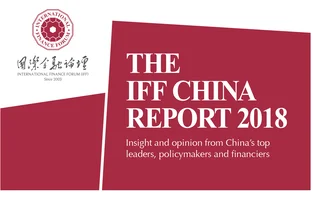
An innovative financial hub in Nansha
The Administrative Committee of China (Guangdong) launched the Guangdong Pilot Free‑Trade Zone with aspirations for the Guangzhou Nansha Free-Trade Zone to become a central financial innovation hub of reform and ‘opening‑up’. By the Administrative Committee of Development Area in Nansha


The cradle of the ancient Maritime Silk Route, Guangzhou is a top-tier Chinese city that has developed into an international trade centre and transport hub. The Nansha District is located in the southernmost part of Guangzhou, bordering the South China Sea and adjoining Hong Kong and Macao. It also sits at the geometric centre of the Guangdong–Hong Kong–Macao Greater Bay Area (the Bay Area Development). Guangzhou endeavours to accelerate the implementation of national strategies, including other new areas and free-trade zones, and fulfils its potential by driving Guangdong Province to becoming a hub of openness and a developing urban subcentre of Guangzhou.
Ports, dealing in trade and finance, usually promote prosperity. As the primary port of Guangzhou and the seventh largest in the world, Nansha accomplished container throughput of more than 14 million 20-foot equivalent units in 2017, and became the largest individual port area in southern China. This hub port has enabled the new trade patterns of Nansha and its innovative financial industry to thrive.
In 2017, Nansha’s cross-border e-commerce accounted for one-sixth of the national total; the financing lease industry expanded rapidly; the first deal of cross-border US dollar ship-charting transaction in assets and the first offshore aircraft lease in the free-trade area of Guangdong Province was completed; and the balance of financing leasing contract exceeded RMB170 billion.
As further evidence of Guangzhou’s success, Nansha port became the largest centre for aircraft leasing in southern China; Guangzhou Shipping Exchange has become the largest shipping trading platform in southern China; and the Pearl River’s shipping price index has become a crucial reference for the development of the global shipping market.
Cross-border trade is booming and cross-border renminbi settlement amounts exceed RMB190 billion. The International Finance Forum (IFF) has also settled in Nansha and an HSBC College launched. Nansha established the first national energy finance demonstration area, and hosts more than 700 venture capital, equity investment and private equity funds. In addition, registered capital totals more than RMB200 billion.
Guangzhou’s strength, which is exerted in building an international financial services hub for the Belt and Road Initiative (BRI), will help Nansha to build a premier brand for financial services by prioritising the financial services system and developing innovative services in the field of technology finance, shipping finance, cross-border finance, wealth management and Bay Area Development financial co-operation. Success will be realised via the following five plans of action:
1. The Guangzhou Nansha International Financial Island Project should apply high standards to planning and construction. The IFF has its operational headquarters in Guangzhou, along with many other international financial organisations. It should welcome important institutions as well as international towns funded by green finance, and an international financial academy and think-tank zone to create an economic landmark in the Greater Bay Area.
2. Promoting trade liberalisation and financial innovation in the Bay Area Development. In accordance with the principles of complementarity, diversity and reciprocity, this free-trade zone will develop its own financial services system, covering the fields of business, tourism, logistics and information, and will adapt to service and trade liberalisation. Efforts will be made to forge in-depth co-operation mechanisms in the insurance market and establish structures in the Bay Area Development that recognise Hong Kong and Macao insurance products, and capital markets connectivity. Additionally, opening financial branch institutions and augmenting the quantities of Hong Kong-invested and jointly ventured securities companies will allow the Bay Area Development to explore the in-depth co-operation mechanisms of the financial services system.
3. Building an innovative platform of international finance co-operation to satisfy the demands for services from the Nansha international shipping and investment trade. This platform can attract new financial institutions and sharpen the district’s edge by connecting domestic and overseas finance businesses, as well as financial trade and services. Additionally, space will be created for cross-border investment and the innovation and development of overseas institutions and domestic bank settlement account systems. Channels for offshore and onshore capital will be opened up to optimise cross-border payment platforms. Cross-border transaction platforms for finance assets will be set up with various products and services. The advancement of a cross-border financing structure in financial markets will continue, broadening investors’ scope, capital flow, production innovation and management.
4. Further integrating industrial finance. Endeavouring to innovate in industrial finance services will provide effective and efficient platforms for industrial development. Nansha will actively support enterprise to conduct model innovation for cross-border and offshore leasing, and explore direct financing in capital markets to promote the construction of local capital market services that offer comprehensive services of industry acceleration, venture capital and list cultivation for domestic enterprises.
5. Sparing no effort in constructing a leading area of financial technology. Given Hong Kong’s strength in financial services and the advanced technology of Guangzhou and Shenzhen, Nansha is capable of building a highly developed brand of financial technology, introducing high-tech finance enterprises, advanced research institutions and modern financial services in the field of venture capital, private equity and financial leasing. Integration between finance, science and industry will be reinforced, as will the industry-academy-research nexus. Authoritative institutions will establish a Guangdong–Hong Kong–Macao institute of financial technology in Nansha and set up a Greater Bay Area international finance technology forum.
Nansha is a dynamic area for investment and entrepreneurship, a shining pearl in the Bay Area Development and a promising city of the future. The district welcomes all those who wish to collaborate and work for mutual benefits.
Only users who have a paid subscription or are part of a corporate subscription are able to print or copy content.
To access these options, along with all other subscription benefits, please contact info@centralbanking.com or view our subscription options here: subscriptions.centralbanking.com/subscribe
You are currently unable to print this content. Please contact info@centralbanking.com to find out more.
You are currently unable to copy this content. Please contact info@centralbanking.com to find out more.
Copyright Infopro Digital Limited. All rights reserved.
As outlined in our terms and conditions, https://www.infopro-digital.com/terms-and-conditions/subscriptions/ (point 2.4), printing is limited to a single copy.
If you would like to purchase additional rights please email info@centralbanking.com test test test
Copyright Infopro Digital Limited. All rights reserved.
You may share this content using our article tools. As outlined in our terms and conditions, https://www.infopro-digital.com/terms-and-conditions/subscriptions/ (clause 2.4), an Authorised User may only make one copy of the materials for their own personal use. You must also comply with the restrictions in clause 2.5.
If you would like to purchase additional rights please email info@centralbanking.com test test test







